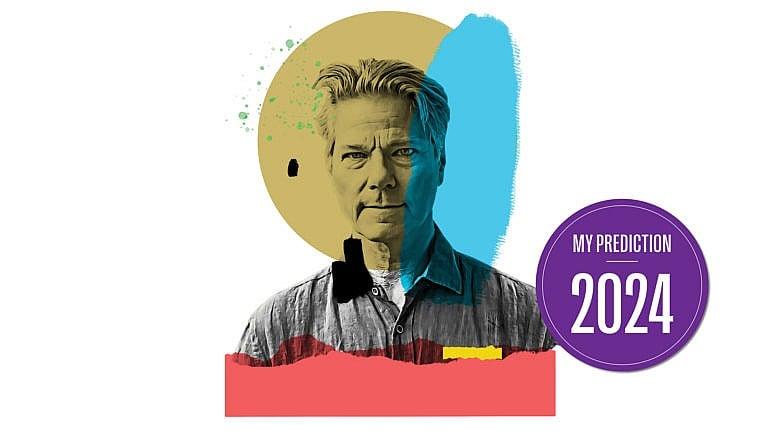Fires will get bigger, faster and hotter—and communities need to prepare
The Earth has a fever, and we’re all feeling the symptoms

(Illustration by Anna Minzhulina)
Share

John Vaillant is the author of Fire Weather: A True Story From a Hotter World
Back in July, the Earth set a new average temperature record, nudging past 17° C for the first time in recorded human history. Headline-worthy as this was, it got lost in this summer’s parade of horribles: fires, floods, heatwaves and hurricanes. The southern United States baked in unrelenting heat. Phoenix broke 43 degrees every day for nearly two months straight, and Antarctica shattered its old record for low ice cover. The implications for our oceans were graver still: in July, the Gulf of Mexico hit 38 degrees off the Florida Keys. Meanwhile, in September, a cyclone called Storm Daniel triggered dam failures that wiped out much of Derna, Libya. More than 4,300 people died, and untold thousands remain missing, presumed washed out to sea. And you thought Canada had a rough summer.
The fact is, we did. We burned, we evacuated, we died, and we broke records, all summer long. Eighteen million hectares of forest burned—nearly eight times the annual average. More than 400 megatonnes of carbon entered the atmosphere. Some 200,000 Canadians were forced to evacuate, while tens of millions of North Americans were shrouded in toxic smoke.
The unifying themes of these events are heat and the energy it generates. For more than two centuries, we have been supercharging our atmosphere and oceans with carbon dioxide and methane, principally through the global exploitation of coal, oil and natural gas. Now, the results are in: just about every climate metric—air temperature, ocean temperature, polar ice loss, glacial ice loss—is increasing. In July, Thomas Smith, an environmental geographer at the London School of Economics, assessed the situation for the BBC: “I’m not aware,” he said, “of a similar period when all parts of the climate system were in record-breaking or abnormal territory.”
Humanity’s obsession with fire-powered energy in all its forms has elevated sea, surface and air temperatures in shocking ways. The steadily increasing number and severity of extreme weather events is the Earth’s equivalent to headache, cough, fatigue and fever. According to climate scientists, our planet is suffering from an acute case of EEI, or the Earth’s energy imbalance. When it comes to absorbing and holding heat, both the oceans and the atmosphere function like giant batteries. The differential between solar energy arriving on Earth and the heat, or solar thermal radiation, leaving it has doubled in the past 15 years alone. Roughly 90 per cent of this excess solar heat is absorbed by the oceans. These lurching step changes are taking us somewhere, and I am here to tell you that it’s not toward a “new normal.” There is no such thing. We are heading into clima incognita, an unknown climate.
Historically, humans have been the ones who outpaced the natural world. From arrowheads to AI, our species has progressed steadily faster than geologic time, leaving indelible marks as we go. But now geologic time, or climate time, is moving as fast, and in some cases faster, than we are: faster than technology, faster than history. No one can predict the future with 100 per cent certainty, but the extreme events of 2023 offer a foretaste of what’s all but certain to come: fire that’s bigger, faster, hotter.
No matter where we live, these inseparable companions—heat and the energy it generates—will shape our collective future in every way. They will determine if we can skate on the Rideau Canal or if we can buy fire insurance in Kelowna. We have some control over this, and Ross Buchanan, a resident of the village of Harrison Hot Springs, B.C. (population 2,000), has seized it. After reading my book, Fire Weather, a non-fiction look at the relationship between wildfire and human behaviour, Buchanan looked at his hometown with fresh eyes and was alarmed by what he saw. The village is a textbook fire trap—a steep-sided, tree-lined valley with a single access road. Buchanan took matters into his own hands and reached out to Jamie Coutts, a fire safety consultant and the current fire chief in the city of Chestermere, Alberta, arranging for him to come to Harrison Hot Springs, assess the village’s preparedness level and present his findings to the community. In late July, 140 people gathered at a local hall to hear about how to better protect their village.
The municipal council approved an action plan for fire preparedness. Among their resolutions: to produce evacuation, prevention and preparedness plans; to hire a paid fire chief rather than rely on volunteer firefighters; to use its annual provincial funding to complete fuel management in the area; and to install fire hydrants along a second evacuation road, in case the first is blocked by fire. Every community in fire-friendly areas should be following Harrison Hot Springs’ example.

This article is part of the Year Ahead 2024, which is Maclean’s annual look at everything that’s coming your way next year. You can buy the print version right here.